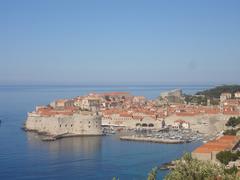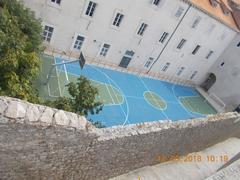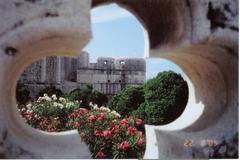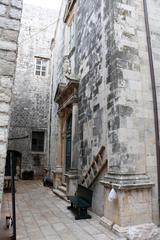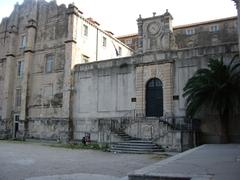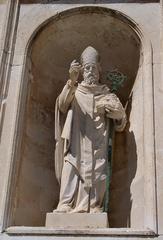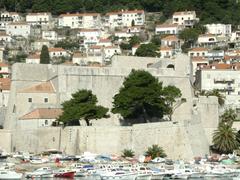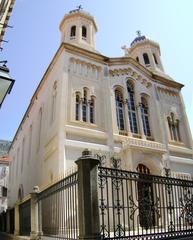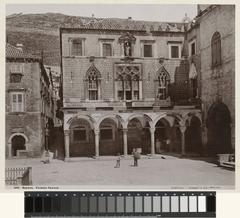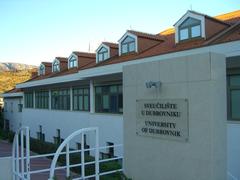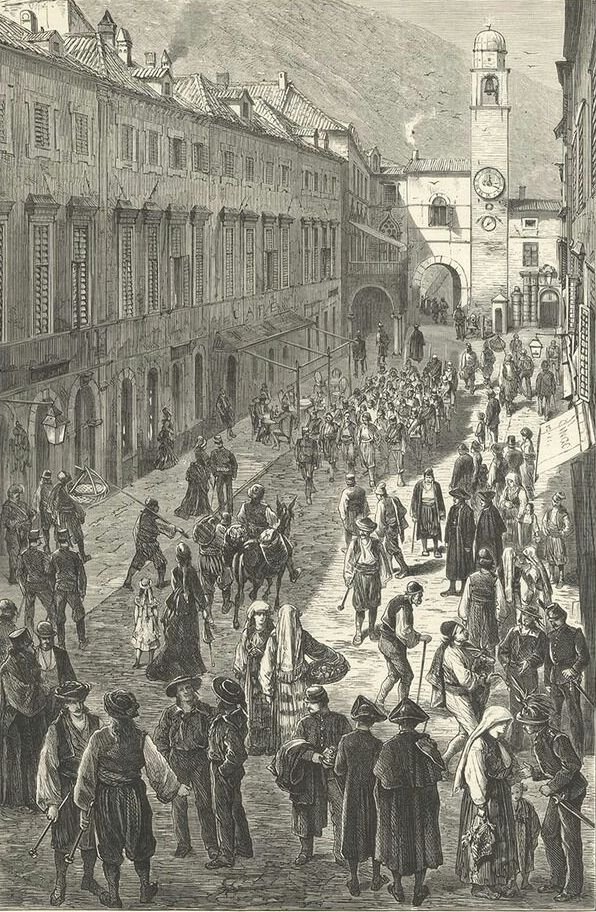
Old City Dubrovnik: Visiting Hours, Tickets, and Historical Sites Guide
Date: 15/06/2025
Introduction: Dubrovnik’s Legacy and Cultural Significance
Dubrovnik’s Old City, honored as the “Pearl of the Adriatic,” stands as one of Europe’s most treasured UNESCO World Heritage Sites. Its blend of medieval architecture, centuries-old city walls, and vibrant cultural life draws millions each year. Founded in the 7th century by refugees escaping Slavic invasions, Dubrovnik rose to prominence as the independent maritime Republic of Ragusa, thriving through diplomacy, trade, and innovation. The city’s urban landscape—marked by Gothic, Renaissance, and Baroque styles—offers a living chronicle of resilience and cultural exchange.
This comprehensive guide provides detailed information on Dubrovnik’s historical sites, practical visiting hours, ticketing advice, and essential travel tips. Whether your interests lie in walking the ancient city walls, exploring palaces and monasteries, or retracing the steps of history (and film), planning ahead will help you make the most of your Dubrovnik adventure (Discover Croatia, Visit Croatia).
Table of Contents
- Historical Overview
- Key Historical Sites
- Visiting Hours and Ticket Information
- Travel Tips and Accessibility
- Nearby Attractions and Events
- FAQs
- Practical Advice
- Conclusion and Resources
1. Historical Overview
Early Origins and Medieval Growth
Dubrovnik traces its roots to the 7th century, when Roman refugees from Epidaurum founded a new settlement on the rocky island of Laus. Over time, this community merged with the Slavic settlement of Dubrava, forming Ragusa—later Dubrovnik. Its strategic location on the Adriatic enabled the city to develop into a vital maritime and trading power by the 9th century (Discover Croatia, Visit Croatia).
The Republic and Architectural Flourish
By the Middle Ages, Dubrovnik had established itself as the Republic of Ragusa, with a sophisticated legal code and a thriving merchant fleet. The city’s prosperity attracted artists, architects, and intellectuals, leading to a golden age of urban development and cultural achievement (Visit Croatia). Major landmarks, including the city walls, Rector’s Palace, and Sponza Palace, were constructed during this era.
Earthquake, Recovery, and Modern Era
A catastrophic earthquake in 1667 destroyed much of the city, but the resilient spirit of Dubrovnik’s citizens drove a Baroque reconstruction that shapes the cityscape today. Foreign rule followed—first under Napoleon and later the Habsburgs—but Dubrovnik retained its cultural vibrancy. The city endured further hardships in the 20th century, notably during the Croatian War of Independence, but international restoration has preserved its unique heritage (The Broke Backpacker).
2. Key Historical Sites
City Walls
Dubrovnik’s city walls, built and reinforced from the 11th to 17th centuries, are among Europe’s best-preserved fortifications. Stretching nearly 2 kilometers and up to 25 meters in height, the walls offer breathtaking views of the Adriatic and the city’s red-roofed skyline. Walking the walls is a signature Dubrovnik experience, taking about 1.5–2 hours (Walk in Dubrovnik, Dubrovnik Travel Experience).
Suggested image: Panoramic city wall view (alt: “Dubrovnik City Walls overlooking Adriatic Sea”)
Rector’s Palace
A masterpiece blending Gothic and Renaissance styles, the Rector’s Palace was the seat of the Republic’s head of state. It now serves as the Cultural History Museum, displaying artifacts of Dubrovnik’s political and social past (Travel Pander).
Sponza Palace
This Renaissance-Gothic landmark, dating from the early 16th century, housed customs, treasury, and archives. It survived the 1667 earthquake and now hosts the city’s archives (The Dubrovnik Times).
Franciscan Monastery & Pharmacy
Famed for its 14th-century cloister and one of Europe’s oldest operational pharmacies (est. 1317), the Franciscan Monastery is an architectural and cultural highlight (Travel Pander).
Fort Lovrijenac
Nicknamed “Dubrovnik’s Gibraltar,” this fortress stands atop a 37-meter rock, defending the city from western attacks. It is a key venue for cultural events and offers panoramic city views (Gateway Travel).
Cathedral and Churches
Key religious sites include the Baroque Dubrovnik Cathedral (rebuilt after 1667), the Church of St. Blaise (patron saint), and Europe’s oldest Sephardic synagogue (Rachel Phipps).
3. Visiting Hours and Ticket Information
- City Walls: Open daily, usually 8:00 AM–7:00 PM in peak season (April–October); hours reduced in winter. Last entry is typically 1 hour before closing.
- Tickets: City walls tickets are €40 (2025), including access to Lovrijenac Fortress. Discounts for students, seniors, and children are available. Purchase at main gates or online to avoid queues (Dubrovnik Travel Experience).
- Major Attractions: Each historical site (e.g., Rector’s Palace, museums, monasteries) has separate entry fees. Consider the Dubrovnik Pass for bundled entry and public transport discounts (Showcasing the Globe).
- Guided Tours: Available for history, Game of Thrones, and culinary themes. Book in advance, especially during high season.
4. Travel Tips and Accessibility
Best Times to Visit
- Shoulder Seasons: April–June and September–October offer fewer crowds, pleasant weather, and lower prices (showcasingtheglobe.com).
- Peak Season: Visit early morning or late afternoon to avoid cruise ship crowds.
Getting Around
- Old City: Entirely pedestrianized with cobblestone streets and many stairs. Wear comfortable, slip-resistant shoes (shippedaway.com).
- Transport: Use the Libertas bus network for travel outside the Old Town. Do not attempt to drive into the Old City—parking is limited and expensive (lonelyplanet.com).
- Accessibility: Some sites offer partial wheelchair access, but expect challenges due to steps and uneven surfaces.
Accommodation
Book well in advance for Old City stays, especially in summer. Consider Lapad or Gruž for quieter lodging with good access (karlatypes.com).
Packing Essentials
- Summer: Light clothing, hat, sunglasses, sunscreen, and water bottle.
- Shoulders/Knees Covered: For religious sites.
- Swimwear: Only for beaches; fines apply for wearing swimwear in the Old Town (shippedaway.com).
5. Nearby Attractions and Events
- Lokrum Island: Nature reserve with botanical gardens, beaches, and historic ruins. Reachable by ferry (The Tour Guy).
- Mount Srđ Cable Car: Offers panoramic views of Dubrovnik and the Adriatic.
- Banje Beach: Popular for swimming and relaxing, just outside Ploče Gate.
- Festivals: The Dubrovnik Summer Festival and Feast of St. Blaise are cultural highlights (Visit Croatia).
6. Frequently Asked Questions (FAQ)
Q: What are the City Walls visiting hours?
A: Typically 8:00 AM–7:00 PM in peak season, with shorter hours off-season.
Q: How much do Dubrovnik tickets cost?
A: City Walls are €40 (2025); other sites vary. Consider the Dubrovnik Pass for multiple attractions.
Q: Are guided tours available?
A: Yes, for history, culture, and Game of Thrones filming locations.
Q: Is the Old City accessible for those with mobility challenges?
A: Many areas have steps and cobblestones; some attractions offer partial accessibility.
Q: Can I drive into the Old Town?
A: No, it’s pedestrian-only. Use public transport or park in designated lots outside.
Q: When is the best time to visit to avoid crowds?
A: Early morning, late afternoon, or outside peak summer months.
7. Practical Advice
- Money: The euro is official currency. Credit cards are widely accepted, but carry cash for small purchases (karlatypes.com).
- Safety: Dubrovnik is very safe; watch for slippery marble streets after rain (lonelyplanet.com).
- Etiquette: Greet locals with “dobar dan” and tip 5–10% in restaurants. Respect dress codes in religious sites.
- Connectivity: Free Wi-Fi is common in cafes and public areas.
8. Conclusion
Dubrovnik’s Old City is a testament to centuries of history, architectural mastery, and a vibrant cultural spirit. By planning with knowledge of visiting hours, ticket options, and practical travel tips, you can explore its ancient walls, grand palaces, and lively traditions with ease. Respect the city’s heritage, support local businesses, and embrace the opportunity to make lasting memories in this Adriatic jewel.
Download the Audiala app for guided tours, up-to-date visiting hours, and insider travel tips. Follow us on social media for the latest news and exclusive content on Dubrovnik and beyond.
Further Reading and References
- The History of Dubrovnik, Discover Croatia
- History of Dubrovnik, Visit Croatia
- Exploring Dubrovnik’s Old Town, Walk in Dubrovnik
- Dubrovnik Itinerary Guide, The Broke Backpacker
- 10 Things You Must Know Visiting Dubrovnik, VIP Holiday Booker
- Best Historic Sites in Dubrovnik, History Hit
- Dubrovnik Travel Guide 2025, Gateway Travel
- Dubrovnik Travel Tips, The Tour Guy
- Dubrovnik Travel Guide, Nomadic Matt
- Dubrovnik Travel Tips and First Visit Advice, Showcasing the Globe
- Dubrovnik Old Town Complete Guide, Karla Types
- Dubrovnik Things to Do, Map and Family
- Things to Know Before Traveling to Dubrovnik, Lonely Planet
- Visiting Dubrovnik Croatia, WaysoftheWorld Blog

